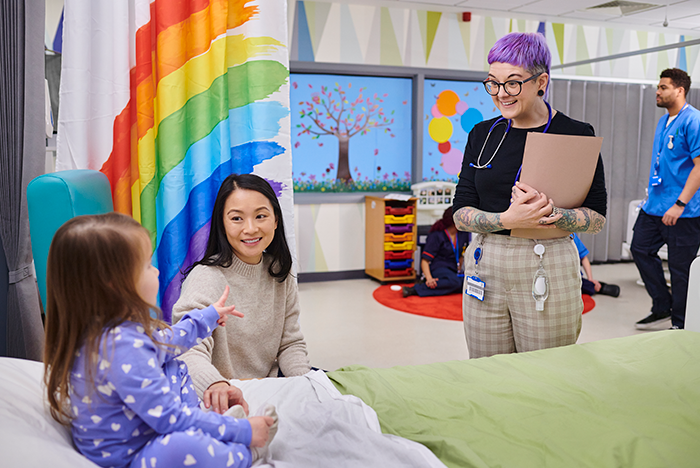Pediatric perspectives in health care design
Children with disabilities spend considerable time in health care spaces, but there is little research examining their experiences. Three recent articles share different ways researchers collected children’s input and include recommendations for future design.
Payam and colleagues used arts-based methods and interviews to collect data from young patients with disabilities, developmental delays, behavioral problems and/or chronic health conditions. Kids drew pictures of different locations within a clinic and then described their artwork.
Results demonstrated a preference for play throughout the facility and distractions in patient rooms. Participants shared that a well-lit, accessible and inviting lobby would help ease the transition from the outside world to the inpatient setting. Finally, kids across age groups shared the importance of wheelchair accessibility, easy to use furniture and their preference for options to personalize their rooms. They felt room features should be able to accommodate all pediatric age groups and adult visitors.
Yu and colleagues conducted a literature review to consolidate findings about how children with disabilities and their families experience pediatric health care environments. Researchers reviewed 19 studies to identify common themes.
A first theme found that social engagement opportunities where kids and parents could share experiences with peers would help them cope with illness and hospitalization. For children whose condition requires them to be room-bound, bedside environments should allow space for therapeutic play. Cafeterias, lounges, atria or gardens might be designed to support older children and adolescents who desire to socialize off the unit.
A second theme highlights children’s preference for color, decorative paintings, natural elements, home-like environments and privacy. Single-patient rooms were preferred because privacy provides a sense of control in unfamiliar circumstances. When single patient rooms aren’t feasible, quiet rooms or reservable meeting rooms can meet individual privacy needs and support private family interactions. However, preferences regarding privacy, decor and parental presence may vary according to different developmental stages.
Goel and colleagues focused their study at a pediatric outpatient facility. Researchers used an iPad to present photographs of distinct facility areas, including the waiting room, pre-procedure room and recovery room, as pediatric patients and their parents visited each respective space.
Participants selected features on the photographs that they liked and disliked and then explained their selections. Both adults and children experienced the most anxiety in the waiting room, with children having greater anxiety prior to the procedure and parents experiencing greater anxiety during the child’s procedure.
Findings suggest that age-appropriate positive distractions in waiting and pre-procedure rooms, such as toys, games, posters, a television or a window, may be beneficial. Children were more likely to favor features that made them feel calm, while adults were most concerned with their child’s comfort or functionality of the space. Both adults and children appreciated furnishings that fostered family closeness.
Care environments for children that balance socialization, play and privacy are best informed by users. These studies included some creative strategies for gathering such input from children.
Research used for this column
The following research citations from The Center for Health Design’s Knowledge Repository of health care design resources were used by the author when writing this column:
- S. Payam et al., “Designing Well-Being: A Qualitative Investigation of Young Patients’ Perspectives on the Material Hospital Environment,” HERD: Health Environments Research & Design Journal, vol. 16, no. 3 (2023): 168–81.
- C. Yu et al., “A Scoping Review of Pediatric Healthcare Built Environment Experiences and Preferences among Children with Disabilities and Their Families,” HERD: Health Environments Research & Design Journal, 2023, in press.
- S. Goel et al., “Design of Pediatric Outpatient Procedure Environments: A Pilot Study to Understand the Perceptions of Patients and Their Parents,” HERD: Health Environments Research & Design Journal, 2024, in press.
About this column
“Design Discoveries” highlights research from The Center for Health Design’s Knowledge Repository, a user-friendly library of health care design resources. This research effort is supported by the American Society for Health Care Engineering, the American Institute of Architects, the Academy of Architecture for Health Foundation and the Facility Guidelines Institute.
Yolanda Keys, Ph.D., R.N., EDAC, is research associate for The Center for Health Design.





